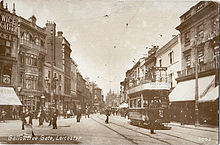Leicester Corporation Tramways
| Leicester Corporation Tramways | |
|---|---|
 Tram on Gallowtree Gate, Leicester ca. 1917 | |
| Operation | |
| Locale | Leicester |
| Open | 1 July 1901 |
| Close | 9 November 1949 |
| Status | Closed |
| Infrastructure | |
| Track gauge | 1,435 mm (4 ft 8+1⁄2 in) |
| Propulsion system(s) | Electric |
| Depot(s) | Abbey Park Road |
| Statistics | |
| Route length | 22.74 miles (36.60 km) |
Leicester Corporation Tramways was a tramway system in Leicester, England from 1901 to 1949.
History[]


The first tramways in Leicester started horse-pulled operation in 1874, by the Leicester Tramways Company. The first route was from the Clock Tower to Belgrave. This was soon followed by lines to and to Victoria Park, which opened in 1875. 1878 saw further extensions, of the Victoria Park line along London Road to Knighton Road, and new arterial routes along Aylestone Road in the south, and to Woodgate in the north.[1][2]
Leicester Corporation took over the tramways in 1901, under the Leicester Corporation Act, and a conversion to electric trams took place in 1904. This was accompanied by a large expansion, with links to Highfields, Clarendon Park, Western Park, and Narborough Road.[2] Further expansions took place from 1915 to 1927.
From the 1920s the Corporation Transport department had run a motor bus service, and these started to replace trams in 1933. The last tram ran in 1949, on the Humberstone Road line. The main depot, at Abbey Park Road, continued in use as a bus depot by First Leicester, the successor to Leicester Corporation buses, until 2007 when a new depot opened on Abbey Lane. The site is to be redeveloped as flats.[3][2][4][5] Another depot stood next to the Bell Hotel on Humberstone Gate.[6]
Network and routes[]
| Section | Opened | Electrified | Closed |
|---|---|---|---|
| Clock Tower – Folly Inn, Belgrave | 1874 | 1904 | |
| Clock Tower – Humberstone Gate – Humberstone Road (Ash Street) | 1875 | 1904 | 1949 |
| Clock Tower – London Road – Victoria Park Road | 1875 | 1904 | 1949 |
| Victoria Park Road – Knighton Drive | 1878 | 1904 | |
| Aylestone Road | 1878 | 1904 | 1947 |
| Clock Tower – Churchgate – Woodgate | 1878 | 1904 | |
| London Road – Melbourne Road – Humberstone Road | 1904 | 1933 | |
| Clock Tower – High Street – Braunston Circle | 1904 | ||
| Braunston Circle – Hinckley Road – Western Park | 1904 | ||
| Braunston Circle – Narborough Road | 1904 | ||
| Hinckley Road – Fosse Road – Woodgate – Great Central Street – High Street | 1904 | ||
| High Street – Groby Road | 1904 | ||
| Belgrave Road – Melton Road | 1905 | ||
| Fosse Road – Braunstone Gate | 1915 | ||
| Clarendon Park – Welford Road – Aylestone Road | 1922 | ||
| Groby Road – Blackbird Road – Abbey Park Road – Belgrave Road | 1924 | ||
| Humberstone Road – Coleman Road | 1927 | 1938 | |
| Humberstone Road – Uppingham Road – St Barnabas Road – East Park Road – Evington Road – London Road[6] | |||
Route numbers were introduced in 1932.[6]
Trams[]
From 1904 the tramway used a fleet of 99 double deck trams, supplemented by an additional 40 in 1905. Twenty new trams arrived in 1913/1914 for an experiment with "pay as you enter" boarding.[6] The last new, numbers 161–178, came into service in 1920.[7]
The National Tramway Museum holds tram No. 76, which was introduced in 1904 with electrification and stayed in use until 1947.[8]
Future[]
In April 2018, the Conservatives announced a policy proposal to revive the tram system should they win control of the City Council at the 2019 local elections, similar to the nearby Nottingham Express Transit system, with work proposed to start in 2020. The proposal was criticised by the current Mayor of Leicester, Peter Soulsby, who stated that studies exploring a revival of the tramway indicated that Leicester's geography was "unsuitable" for a modern tram network.[9] In March 2019, plans were revealed for a tram network that would have 40 stops and built in two phases.[10]
References[]
- ^ "Belgrave Trams & Toll Gates". Leicester City Council. Archived from the original on 5 August 2012. Retrieved 9 November 2009.
- ^ a b c Peter Gould. "Leicester Corporation Transport". Retrieved 9 November 2009.
- ^ "Leicester Trams". Archived from the original on 3 December 2008. Retrieved 9 November 2009.
- ^ "First Leicester Bus Depot". Lost Places. Retrieved 28 June 2021.
- ^ "Anger at plans for new bus depot". BBC News. 27 October 2004. Retrieved 9 November 2009.
- ^ a b c d Creese, Geoff (2006). Leicester and its Trams: Tramscape and Townscape, 1903–1949. Irwell Press Ltd. ISBN 1-903266-68-8.
- ^ Peter Gould. "Leicester Corporation Transport: Tram Fleet List". Retrieved 9 November 2009.
- ^ "Tram Fleet". National Tramway Museum. Archived from the original on 1 April 2009. Retrieved 9 November 2009.
- ^ "Plan unveiled to build city tram network - if Tories win election". Leicester Mercury. 19 April 2018.
- ^ "40 tram stop locations set out in proposed £500m plan". Leicester Mercury. 11 March 2019.
External links[]
- Tram transport in England
- Transport in Leicestershire
- Companies based in Leicester